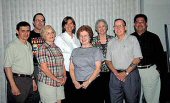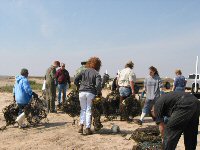Volunteering for the future
Connie Stolte, Visitor Center Manager, Sea Center Texas
People fish for many different reasons, including recreation, relaxation, food, competition, being outdoors, spending time with family and friend or just having great fun. But whatever the reasons, the ones who keep fishing are getting something good from their experience, that’s why they keep doing it. Sometimes anglers even increase their benefits by volunteering for something related to fishing. Knowing that they are helping conserve and enhance coastal Texas at the same time they are having fun (or working hard) is what volunteers for coastal programs like the Sea Center Texas Visitor Center, collecting abandoned crab traps, working behind the scenes at the CCA/CPL Marine Development Center, or participating in the Texas Gulf Coast Roundup know firsthand.
In 1991, Texas Parks and Wildlife Department decided to add a visitor center to the fish hatchery being built in Lake Jackson, realizing that volunteers would be needed to assist with visitor services. What TPWD did not know then was how the Brazosport community would embrace and support the facility and how successful the volunteers would make Sea Center. From the beginning, a committee of volunteers was used to recruit new volunteers to work at the facility giving tours, and staffing the facility touch tank and gift shop. The facility opened in 1995 with a full staff of over 80 volunteers and since then about 600 volunteers have spent some time working there.

Volunteers like Clarence and JoAnn Forse, Mary Helen Israel, Jose Salazar and others have kept the volunteer program alive and interesting. JoAnn was one of the first volunteers to help with the gift shop at the facility and continues to recruit other volunteers, scheduling volunteer time and filling in for those that can’t make their regularly scheduled shift. Her husband, Clarence received his 4,500-hour volunteer pin this year and joked that he should get his own desk when he hits 5,000. He also put in many hours at home building reel holders and coordinating the youth fishing events he supervises each week. The volunteer group that helps kids fish each week say they never get tired of watching someone catch their first fish. Jose Salazar is a young high school student who has chosen to spend most Saturdays at Sea Center Texas as a touch tank interpreter and as a tour guide. He enthusiastically greets many visitors and because he is fluent in Spanish often introduces Spanish speaking visitors to the facility. Mary Helen Israel is the first and only Secretary of the Volunteer Advisory Board, but she also works as a gift shop volunteer and the editor for the monthly volunteer newsletter. Other volunteers have developed a fly tying class, written a special book and song about “Gordon the Grouper”, and gone to outside events as “ experts” with the touch tank and aquarium fish.

The volunteers family that has formed at Sea Center over the years take care of each other, share their joys and sorrows, but most of all they have some great times together helping take care of Texas by working with visitors, especially youngsters, and teaching them about marine resources. They don’t always have an easy time, especially when a group of kids on a tour have been acting up instead of listening but they realize that overall the messages that they are bringing to tomorrow’s conservationists are important. They work to open the eyes of young visitors to the world around them, especially urban youth who might never otherwise have a chance to see the natural resources of our coast.
However, some people are not comfortable talking to the public. They could become a volunteer behind the scenes like Harold Lewis at the CCA-CPL Marine Development Center in Corpus Christi. As an avid saltwater angler and an early member of coastal conservation organizations, Harold wanted to give something back to the coastal environment that had given him so much enjoyment. In 1985, just after he’d retired, he volunteered to help and he’s has been a mainstay for carpentry, plumbing, and construction jobs ever since. He’s worked over 11,000 hours and contributed substantially to the production of red drum from the hatchery and this was in spite of a major heart attack and all the life events that happen during an 18-year span.
Not everyone can devote so much time or may want to work closer to the water, so for them TPWD asks volunteers to help collect and dispose of abandoned crab traps each spring. After a two-year effort by hundreds of staff and volunteers, the cleanup effect is noticeable and a third year is planned. In the first year, more than 8,000 traps were picked up by volunteers across all the bay systems of Texas. It wasn’t easy or pretty work, but by the end of the day more than 550 volunteers from 60+ organizations along the coast went home feeling tired, sore, and useful. They were able to help the animals that would have been accidentally trapped (estimated 11,000+ organisms) by the unattended crab traps, clean up the bays and remove potential obstructions for anglers and boaters in those areas.

Other volunteer opportunities are available for marine conservation, state parks, wildlife management areas, local beach cleanup drives, etc. For example, some anglers have been able to help TPWD collect certain types and sizes of fish just by fishing in specific places at specific times. The Texas Gulf Coast Roundup has conducted several fishing events each year to help TPWD collect fish for broodstock, aquarium displays or educational or research purposes. Just another day fishing at the coast -- except you don’t keep the fish you catch, but you feel good about giving them up.
If you are interested in using your time or expertise for coastal resources, look on the TPWD website or contact any of the local offices, hatcheries, parks, facilities or staff and say “I’d like to volunteer”. You might decide it is worth the effort.
© Copyright Texas Parks and Wildlife Department. No part of this work may be copied, reproduced, or translated in any form or medium without the prior written consent of Texas Parks Wildlife Department except where specifically noted. If you want to use these articles, see Site Policies